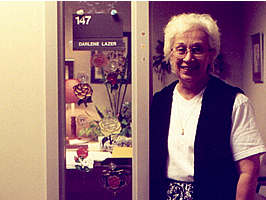Editor’s note: This is one in a series of articles Mn/DOT Newsline is publishing
looking back on the department’s first 25 years—remembering the people, issues
and cultural forces that have shaped the agency and the milestones Mn/DOT has
achieved.
The society in which Mn/DOT operates has undergone substantial change since
the agency’s birth in 1976. Educational levels and career expectations rose.
 |
|
From left to right:
Will Dalman, Dave Pederson and Dan Busch at work in 1978 were part of
a rather homogenous workforce.
|
Baby boomers and women entered the workforce in record numbers. Minority group
members knocked on the doors as well.
Mn/DOT was born in this landscape, and from the very start, the faces in its
workforce began to change in some areas. Some parts of the agency saw very little
change; others saw overnight differences—including Mn/DOT’s top-staff.
Headline news
Newspaper headlines in 1976 and 1977 chronicled Mn/DOT’s changing management
team, often rather bluntly. For example:
"Department puts its lobbying in woman’s hands: For the first
time, the state Transportation Department, formerly known as the Department
of Highways, will send a woman to do what was known as a man’s job on Capitol
Hill. She is Ellen Temple, the department’s assistant commissioner for government
and community relations." (St. Paul Dispatch, Dec. 10, 1976)
The next day, the Minneapolis Tribune reported that the appointment of Mn/DOT’s
first official communications director had been blocked because equal employment
opportunity guidelines had not been followed. A few weeks later, the St. Paul
Pioneer Press reported that Patricia McKinney, a black woman, had been hired
for that job amid charges of "reverse bias."
 |
|
From the very start,
Mn/DOT had women and minorities in top management. Mn/DOT’s first black
woman manager, Sherri Alston, was appointed assistant commissioner for
Mn/DOT’s public transportation division in December, 1976.
|
The bottom line—how Mn/DOT’s faces changed
The ‘bottom line’ varies considerably from one part of the agency to another.
Assessments also depend on what factors you look at: gender, race, ethnic background,
age group, education, career skills, bargaining unit, or reasons for working
here.
According to Rich Peterson, assistant director, Human Resources, "The
total number of employees has remained relatively constant, but the mix has
changed. We are trying to mirror the community we serve."
Expanding on this, Mike Garza, Equal Employment Opportunity/Contract Management
director, said: "Change may not be apparent in some units, but take
a 100-member cross section of Mn/DOT and you will see more women, more people
of color, more generations, more career types—in all occupations and at all
levels of the organization."
Mn/DOT’s workforce—the early years
Despite the headlines, the vast majority of Mn/DOT’s workforce was more
homogenous. The Department of Employee Relations’ 1987 Biennial Work Force Report
reported that Mn/DOT had 4,911 employees in 1976. Only 5 percent of these employees
worked outside of construction, maintenance, engineering services, planning
or design. Most were white, male and more than 25 years of age.
Mn/DOT’s total size has hovered around 5,200 employees—plus or minus a few
hundred—ever since, but the career mix has indeed changed. Mn/DOT has hired
more than 250 computer professionals, along with another 250 people in communications,
graphic design, training, safety and wellness.
The mix of genders and races/ethnic groups has also changed over time. Mn/DOT
has experienced a slow, steady increase in women employees (but not of women
managers) since 1985. Minority employment doubled, but the number of employees
with self-reported disabilities fluctuated and even went down.
|
What people are
saying about our changing ‘face’
"It hasn’t changed much over the years, at least in the Sauk Centre
construction office. The only thing that changed was we hired some women
for typing and dictation."
– Mickey Klasen, bridge project supervisor, District 3
‘This is really the first time that we’ve seen so many generational
groups in the workforce."
- Theresa Johnson, assistant staffing manager, Human Resources
"On the managers level, we’ve been holding steady at 3-4 percent
of managers who are people of color. That’s significantly behind our
community’s percentage at that level."
- Adeel Lari, Research director
|
What the numbers say
Compare these statistics from Mn/DOT Human Resources:
1985
5,160 employees. Men: 85.5 percent. Women: 14.7 percent. Minorities: 3.6
percent. People with disabilities: 8.9 percent.
1990
5,478 employees. Men: 84.8 percent. Women: 15.6 percent. Minorities: 4.1
percent. People with disabilities: 6.7 percent.
1995
5,127 employees. Men: 81.4 percent. Women: 18.7 percent. Minorities: 5.4
percent. People with disabilities: 5.9 percent.
2001
5,637 employees. Men: 77.9 percent. Women: 22.3 percent. Minorities: 7.3
percent. People with disabilities: 6.6 percent.
Many eyes go over data such as this, including staff from EEO/Contract Management
and Human Resources, along with departmental and local diversity task forces
and management teams.
The consensus opinion: when it comes to matching the diversity within the country,
the state and each Mn/DOT district, the agency has made some progress but still
needs to do more.
Gary Simon, Mn/DOT recruitment team leader, provided statistics that showed
that Mn/DOT is still significantly behind both Minnesota’s percentages of minority
and women workers, and even further behind the country’s as a whole.
"The percentages (of diversity employees) may differ from district to
district, and from one bargaining unit to another," explained Garza. "But
these statistics represent years of recruiting effort, with Mn/DOT trying to
embrace change."
 |
|
"When I first
came here, they hadn’t hired anyone in 13 years, women didn’t work in
the field, and there were no women maintenance workers. Now, in the engineering
area, we’ve hired two more women, and there’s at least one woman in each
maintenance area." – Roberta Dwyer, consultant program project manager,
District 1
|
Where the changes occurred—and still need to change
Garza has compared district employment statistics with their population
data from the 2000 census. This helps provide district-specific benchmarks,
with each district drawing from the local workforce pool.
"We want the districts to match their communities," he said. "It
was really an eye opener to visit the districts and see the efforts they are
making to recruit a more diverse workforce. People are trying to do the right
thing."
The EEO office also tracks employment statistics by bargaining unit and type
of work. These numbers show where sometimes-innovative recruiting methods (such
as the highway maintenance worker trainee programs) have made an impact, and
where more still needs to be tried.
Retirements and transfers—the new wave
American workers are not staying as long at the same jobs as they did in
the past. But Mn/DOT has another huge problem: its workforce is now reaching
retirement age in record numbers.
"We’re seeing a lot of highly experienced talent eligible for retirement
in the next few years," Peterson said. "Historically, employees would
work five years longer after reaching retirement age. Now they’re working three
years longer, then leaving. Experienced talent is going out the door sooner
after they become eligible for retirement."
This has implications on employee roles and training, according to Theresa
Johnson, assistant staffing manager, Human Resources. "Knowledge transfer
has become critical," she said, citing Mn/DOT managers’ growing usage of
both retirees and employees who are approaching retirement as mentors to pass
on knowledge they’ve gained.
Hiring practices have also changed, Johnson commented. She cited an insight
from Brenda Wrobel, District 8 administrative manager, who observed that "Historically,
Mn/DOT has filled gaps with what they currently had as opposed to what they
needed, now and into the future."
|
The generational
mix
1922-1946
"Veterans" (Depression era and World War II)
1946-1964
"Baby boomers"
1965-1980
"Generation X"; "X-ers"
1980-forward
"Generation Y"; "Nexters"; or "Millennium generation"
|
Recruiting the new faces of Mn/DOT
Not only is the workforce becoming more racially and ethnically diverse,
it’s aging as well. DOER reports that "The Minnesota labor force will see
significant increases in the older populations and slight declines in the younger
generations entering the workforce." This makes it harder to attract new
talent to replace retirees.
Another complicating factor, Simon said, is that fewer young people are looking
at transportation careers.
"The groups that feed our applicant pool (schools, etc.) have shrunk,"
added Peterson. "We’ve found we have to tap into the high schools and even
grade schools to nurture the talent that we need." This includes school
outreach programs such as Seeds and TRAC.
Changing workforce, changing ways of work
Nonetheless, new generations are entering the workforce, bringing new supervisory
needs as well. "For the first time, we’re seeing four generations in the
workforce at the same time," Peterson said, "and it adds complexity
to the way we manage people and the way we manage work."
"The needs of job candidates have changed significantly," he said,
adding that "To be the ‘employer of choice,’ to attract and retain good
employees, we’re now promoting work/life balance programs."
Peterson listed some of those "life balance issues" that have generated
new initiatives: "telecommuting, flex schedules, family medical leave act,
wellness and fitness issues. It all enhances our ability to attract and retain
talent," he said.
 |
|
"I’m happy to
see changing attitudes towards office assistants and our work, with development
of more career paths. I think it’s very important that we be thought of
as a vital part of the team." - Darlene Lazer, executive assistant
to the division director, Metro Division (photo by Kent Barnard)
|
Garza said he also believes that quality of life combined with distance learning
and increased job opportunities could reverse the ‘brain drain’ that has historically
drawn many of the young and the educated from Greater Minnesota to the urban
areas.
"The ‘brain drain’ doesn’t want to leave Greater Minnesota," Garza
said. "They’d like to stay where they are and get their education and jobs
in the areas were they grew up."
With so much evolution taking place, what’s the bottom line?
"I think the message people need to hear," said Garza, "is that
we’re doing things in every district to recruit and retain a diverse workforce.
The message remains strong from upper management: we’re paying attention to
the distribution of our workforce because it is good business—and it helps us
to better serve our communities."
|


